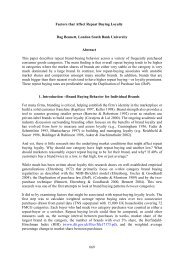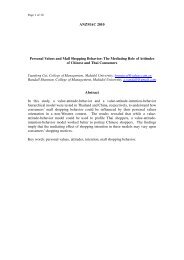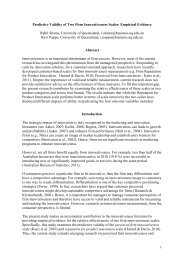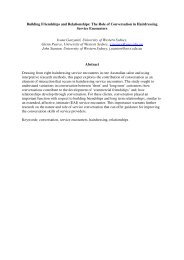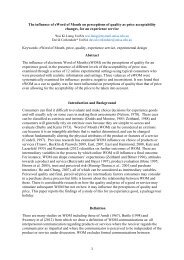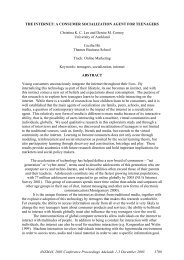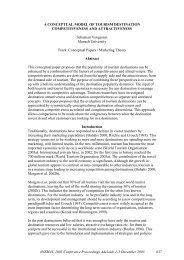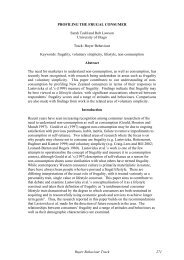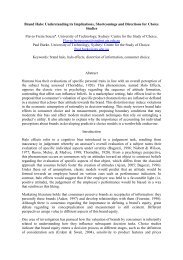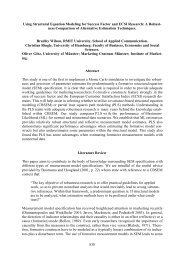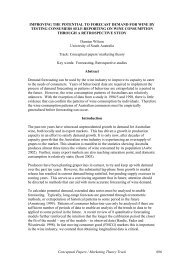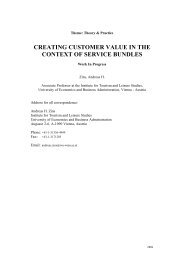amj Australasian Marketing Journal - ANZMAC
amj Australasian Marketing Journal - ANZMAC
amj Australasian Marketing Journal - ANZMAC
Create successful ePaper yourself
Turn your PDF publications into a flip-book with our unique Google optimized e-Paper software.
Advertising Self-Regulation<br />
scale, internalising the benefits of productive actions and<br />
changing the balance of power between participants in the<br />
exchange process (Harris and Carman, 1984), it is apparent<br />
that the ASC achieved more effective collective action than<br />
the ASB now does.<br />
Without the national tripartite system in place during the<br />
ASC s reign, whereby advertisers were forced to remove<br />
unacceptable ads, the ASB struggles to achieve any real sense<br />
of collectivity amongst the industry. Economies of scale,<br />
apparent in a national tripartite system, are not achieved without<br />
the, now extinct, Media Council s input and the benefits<br />
of productive actions are similarly stifled as there is constant<br />
uncertainty amongst all parties in regard to the balance of<br />
power. Certainly Gupta and Lad s (1983) suggestion that<br />
industry self-regulation will only take place if the firms in the<br />
industry decide to cooperate with each other, is validated here<br />
in the case of the advertising industry in the 21st century in<br />
Australia. Since inception in 1998, the ASB has received<br />
prolonged and severe criticism from many commentators,<br />
including the advertising industry, and the very uncertainty of<br />
the compliance process has produced timidity from the<br />
complaint handling body, evidenced by the 5% uphold rate<br />
discussed earlier.<br />
Prevailing community standards are usually achieved by<br />
involving the public in the complaint handling process; this<br />
involvement can be at two levels, as complainants and as<br />
members of the complaint determination board. As<br />
complainants, the public is now provided with a stand-alone<br />
panel set up with the sole purpose of determining complaints<br />
about taste and decency, traditionally the domain of the general<br />
public. This is a positive move. As is the fact that there are<br />
now nearly twice as many complaints overall, compared to<br />
the last year of the ASC s reign. More complaints means that<br />
the public awareness message is getting through to those<br />
concerned with unacceptable advertising.<br />
Understanding the ASR process involves not only examining<br />
how the systems operate but also who is involved in the<br />
process. Both systems involve(d) the public in the complaint<br />
adjudication process which, arguably, leads to increased<br />
effectiveness of the program (LaBarbera, 1980; Boddewyn,<br />
1983; Armstrong and Ozanne, 1983; Moyer and Banks, 1977;<br />
Trade Practices Commission, 1988), and provides a credible<br />
and transparent process which is open to all stakeholders. The<br />
old system operated with a 10:6 ratio of public:industry<br />
members on the Council, whilst the new system has 14 nonindustry<br />
members.<br />
Whereas the old ASC relied on ex-Supreme Court Judges, ex-<br />
Deputy Prime Ministers, ex-State Premiers, Lawyers,<br />
Doctors, sporting greats and the like, the new ASB adopts a<br />
slightly different recruitment policy with board members<br />
from the worlds of business, media, academe and sport.<br />
Specifically, the ASB draws on the services of the great and<br />
14 <strong>Australasian</strong> <strong>Marketing</strong> <strong>Journal</strong> 9 (1), 2001<br />
the good (Boddewyn, 1983) such as prominent businesswoman,<br />
Sara Henderson, media personalities, Mary<br />
Kostakidis, Margaret Pomeranz and Carmel Travers, sporting<br />
afficionados Roy Masters, John Konrads and Geoff Lawson,<br />
author Thomas Keneally, public servants John Brown and<br />
Wendy McCarthy, students Joanna Cohen and Kate Williams,<br />
and others who have worked in advertising and marketing<br />
research, such as Graham Cox and Brian Sweeney (ASB<br />
Annual Report, 1999).<br />
The legal regulatory framework for advertising in Australia has<br />
changed little over the past three decades, with the Trade<br />
Practices Act and Broadcasting Services Act being the main<br />
pieces of legislation pertaining to this activity. The key difference<br />
between the two regimes, however, lies in the change-over<br />
from the Trades Practices Commission to the Australian<br />
Competition and Consumer Commission as the body concerned<br />
with monitoring the effectiveness of ASR. Whilst the ACCC<br />
were the catalyst that brought about the demise of the MCA and<br />
ASC in 1996, it is now closely monitoring the ASB.<br />
In terms of the ASR framework, and in particular the complaint<br />
handling bodies, both systems operate(d) in a similar precedential<br />
manner but each has(had) a varying degree of effectiveness<br />
in this regard. Both systems require(d) a complaint to<br />
be in writing and this in itself is problematical for the illiterate,<br />
poorly educated and inarticulate members of society who,<br />
nevertheless, have a fundamental right to complain. Each of<br />
the systems then filter(s) the complaints to gauge if a prima<br />
facie case exists, or if the complaint is outside the jurisdiction<br />
of the body. However, whilst the ASC filtered out 50% of all<br />
complaints that were delivered to the secretariat, thus only<br />
allowing 50% to be heard at a Council meeting, the new<br />
administration endeavours to hear almost all of the complaints<br />
that are received by their secretariat (Fraser, 1999).<br />
In both systems, once determination is(was) made, a formal<br />
written communication is(was) sent to advertisers,<br />
complainants and the media involved. However, under the old<br />
4<br />
The AFA s Code of Ethics was first unveiled at the beginning of 1998,<br />
just after the collapse of the ASC and MCA. The Code has recently<br />
been re-written and launched again (Sinclair 2001).<br />
5<br />
NB Whilst this table is concerned with the ASR systems and codes<br />
administered by the ASC and ASB, it should be noted that an industrybacked<br />
Alcohol Beverages Advertising Code and Complaints<br />
Management System was introduced in July 1998 by the liquor industry<br />
(Wooldridge 1998). This ABAC is not included in discussions in<br />
this paper as it is outside the control of the ASB, although the Bureau<br />
does forward suitable complaints onto the administrators of that code.<br />
Similarly, other industry bodies, such as the AFA, abide by their own<br />
codes of ethics or conduct and, likewise, these are not discussed here<br />
for the same reason.



